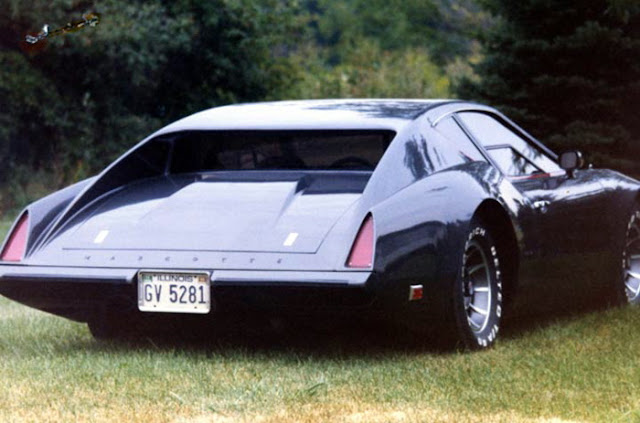Maxton's Magnificent but Unfinished GT
American auto enthusiast and entrepreneur, Robert Sutherland, is probably best known for his RX-7 powered Maxton Rollerskate kit car. It was an instant classic, combining the ethos of a Lotus 7 with the power of a Japanese rotary engine, while offering spirited performance and contemporary styling. It was widely praised by the automotive press and was featured on the Public Television program Motor Week, in a multipart series, which followed the building of a Rollerskate kit for several installments over a season of the show. However, Robert Sutherland wasn't going to rest on his laurels. He envisioned something truly audacious for his next act.
Thus, the Maxton GT began its design and development in 1990, just as the Rollerskate was nearly ready for its debut to the press and ultimately its customers. The GT was to be an even more ambitious design than its roadster stablemate; a gull-wing coupe, with drivetrain components derived from the Ford Sierra Cosworth series of rally racecars, mounted to a chassis modeled after the classic Lotus Elan. It was to be a high-performance, upscale compliment to the Rollerskate and flagship model for Maxton. Engineering and prototyping of the chassis were done by Spydercars which is a company in the UK who fabricate replacement frames and suspension components for Lotus cars, as well as producing custom chassis for specialty vehicles.
The car was powered by a Ford Sierra Cosworth YB turbocharged and intercooled, 16-valve, 2-liter motor, with a 5-speed Ford Sierra transmission. The engine was built by the renowned craftsman, Terry Hoyle, to Group N specifications at an estimated 285 horsepower. The complete powertrain: engine, clutch, gearbox, rear end, and half shafts, as well as brakes and instruments, were sourced from an early ‘90s Ford (UK) Sierra Cosworth RS500 rally car.
The complete wiring harness and engine management system, from its very special donor car, were included in the rolling chassis since they were intended for use in the development prototype, once the bodywork and chassis were united. The GT was equipped with Koni shocks, Revolution wheels, dual custom aluminum gas tanks, a Corbeau seat, and a Momo steering wheel. The Cosworth YB series motors could be tuned to a reliable 500 HP, and the Ford Sierra Cosworth RS500 racers were unbeatable in their day, competing in World Rally Championship racing. A similar level of performance was anticipated in Maxton's intended product.
This car was featured on the cover of the May 1992 issue of "Cars and Car Conversions Magazine", which included an article about the chassis construction as well as a test drive of the chassis, sans bodywork. Sutherland had commissioned several technical and styling drawings of both a roadster and gullwing version of the body for the vehicle and scale models were built. In addition, a full-size body buck was created. Mike Mate, who also designed the Rollerskate, was responsible for the GT's styling. After production and testing in the UK, the chassis and accompanying materials were shipped to Maxton, in Englewood, Colorado (USA), where they remained until Robert Sutherland's untimely death.
The subsequent owner of the chassis planned to use it to replace the chassis and drivetrain of the Lotus Elan Plus 2 which they also owned at the time. However, the wheelbase and track of the two vehicles did not match up well enough to make that conversion feasible. It was later found that the wheelbase and track measurements of a Jensen Healey corresponded precisely to those of the GT, so a running example of that was acquired with the intention of using its body (as well as its title and registration) to construct a road legal, street-able custom with the much more sophisticated chassis of the Spydersport and its prodigious horsepower. The installation would have conferred the distinct advantages of reduced weight and more than double the horsepower. It would have been quite the little monster!
However, this never came to pass, and the Maxton GT chassis was put up for sale in 2020. At this time its whereabouts are unknown to the author. One would hope that the current owner, whomever that may be, sees fit to finish the GT in its intended gull-wing coupe bodywork. Nonetheless, the ultimate story of the car's fate remains unwritten. It's another tantalizing "what if" in the history of independent sportscar makers.
A note on the digital illustrations accompanying this article:
The included illustrations, produced by the author (John Mellberg), are the property thereof and all rights are reserved. These were produced in February of 2024 using scanned images of pen & ink line art and enhanced using image editing software (Photoshop), as well as generative imaging tools (Vizcom AI). These were based on the original drawings from Maxton, included here in the article but some artistic license may be inferred. It is the author's hope that they help add some realism to the original vision behind the Maxton GT and do the effort the justice it richly deserves. It is a car that would likely have been amazing had it ever fully reached fruition. As it stands, it was one heck of a start.
 |
| Original Maxton GT rear view drawing by Mike Mate |
 |
| The Maxton GT rolling chassis, front-right view. |
 |
| Original Maxton GT top view drawing, by Mike Mate, with notional packaging. |
 |
| The Maxton GT drawings, by Mike Mate, with scale Rollerskate model in foreground |
 |
| A ballpoint pen sketch of the Maxton GT by the author |
 |
| A digital illustration of the Maxton GT, in red, by the author |
 |
| A digital illustration of the Maxton GT, in red, by the author |
 |
| The Maxton GT's glorious Cosworth motor |
 |
| The Maxton GT rolling chassis at rear |









Comments
Post a Comment